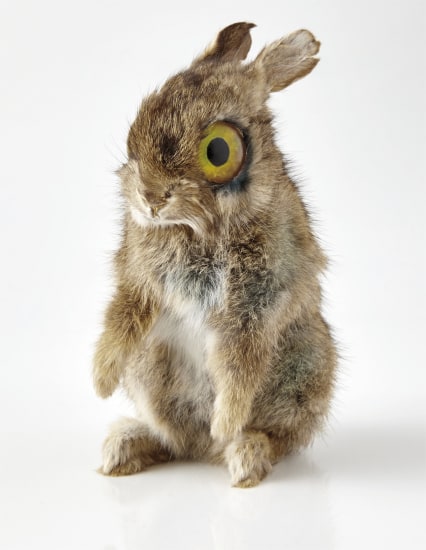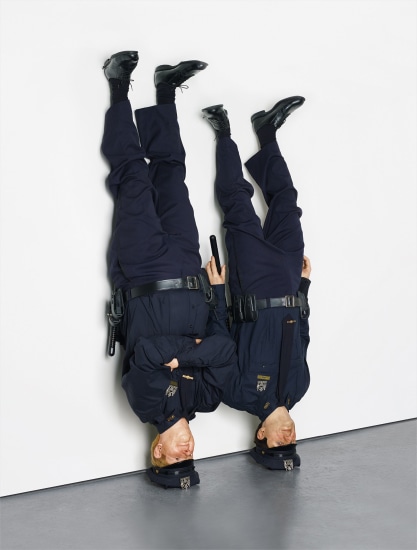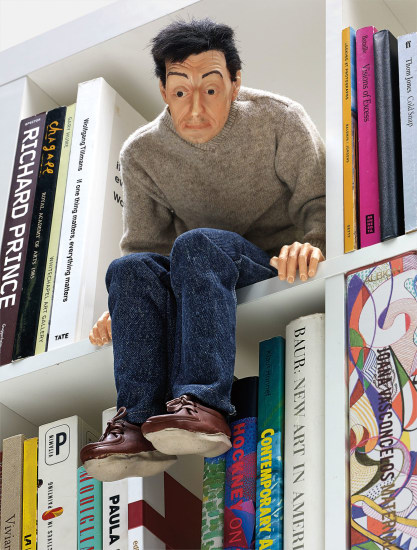Maurizio Cattelan Stephanie Executed in 2003 Colored pigment, wax, synthetic hair, glass, metal. 43 5/16 x 25 9/16 x 16 9/16 in. (110 x 64.9 x 42.1 cm). This work is from an edition of 3 plus 1 AP.
Provenance Galerie Emmanuel Perrotin, Paris Catalogue Essay Like a Virgin By MASSIMILIANO GIONI Maurizio Cattelan likes to mix affection with a dose of confrontation, particularly when it comes to dealing with those in positions of power. Most notoriously, Cattelan has directed this tough love in the direction of his gallerists. In 1994, he convinced his legendarily promiscuous dealer Emmanuel Perrotin to sport an unwieldy, pink costume, resembling a hybrid of a rabbit and a phallus, for the duration of Cattelan’s show (Errotin le Vrai Lapin, 1994). In 1999, he staged a secular crucifixion by duct taping his Milanese dealer Massimo De Carlo to a gallery wall, in a performance that eventually ended with De Carlo having to be rushed to the hospital (A Perfect Day, 1999). However, Cattelan has also directed below-the-belt jabs toward his high profile collectors, particularly those who commission works from him. In 2002, for instance, when Cattelan was commissioned to create a piece for London dealer Ben Brown, he produced a life-sized, hyperrealistic waxwork likeness of his recently deceased grandmother which was installed in Brown’s refrigerator (Betsy, 2002). Recently, in response to a commission request from collector François Pinault, Cattelan proposed a tombstone bearing the epitaph “Pourquoi moi?” Cattelan’s work Stephanie, 2003, a portrait commissioned by newsprint magnate and magazine publisher Peter Brant of his wife Stephanie Seymour, is a similarly double-edged work. For the commission, Cattelan employed the talents of his frequent collaborator, Daniel Druet a highly regarded Parisian waxwork sculptor, who spent two years working with Cattelan on the project. The result was a lifelike, nude waxwork of Seymour, a legendary supermodel whose image has graced over three hundred magazine covers. Designed to be mounted on the wall, the piece turned the effigy of Stephanie Seymour into a literal trophy wife. Cattelan found inspiration for his portrait during a visit to Brant’s palatial residence in Connecticut, where he apparently remarked that among Brant’s many impressive trophies, which include world-class holdings of Warhol, Basquiat, Koons, and Lichtenstein, as well as numerous mounted heads of large and exotic game, his most remarkable was certainly Seymour herself. As a result, Cattelan’s portrait resembles nothing so much as a prize commemorating a particularly rarified catch from a high-stakes social safari: like the neck of a gazelle, Seymour’s voluptuous form arches gracefully out of the wall, hands demurely cupped to her breasts, hair perfectly coiffed on the occasion of the Phillips de Pury auction by worldrenowned stylist Frédéric Fekkai (fig 1). With a becalmed, regal look on her face, she is the very picture of beauty, frozen in the headlights. Stephanie certainly has mischievous overtones that suggest Cattelan may have been having fun at his commissioner’s expense, but the work also resonates in ways that pushes it beyond the bounds of a simple prank. Most readily apparent is Stephanie’s resemblance to a ship’s figurehead, the often elaborate, carved-wood figures that adorned the prows of ships between the 16th and 19th centuries (fig 2). In more recent history, these figures, which largely took the shape of either women or animals, were used to either relay the name of the ship, or to display the wealth of the ship’s owner — a similar function to that of an art collection or, for that matter, a trophy wife. Originally, however, ships’ figureheads were thought to protect the ship to which they were fastened from the malevolent forces of the sea. With this in mind Stephanie takes on a more ambiguous meaning — part bauble, part talisman, her figure both connotes opulence, and exudes maternal warmth and safety. In addition to Stephanie’s association with nautical ornamentation, the work should also be viewed in terms of its relation to the history of portraiture, and particularly to the history of the represent
Maurizio Cattelan Stephanie Executed in 2003 Colored pigment, wax, synthetic hair, glass, metal. 43 5/16 x 25 9/16 x 16 9/16 in. (110 x 64.9 x 42.1 cm). This work is from an edition of 3 plus 1 AP.
Provenance Galerie Emmanuel Perrotin, Paris Catalogue Essay Like a Virgin By MASSIMILIANO GIONI Maurizio Cattelan likes to mix affection with a dose of confrontation, particularly when it comes to dealing with those in positions of power. Most notoriously, Cattelan has directed this tough love in the direction of his gallerists. In 1994, he convinced his legendarily promiscuous dealer Emmanuel Perrotin to sport an unwieldy, pink costume, resembling a hybrid of a rabbit and a phallus, for the duration of Cattelan’s show (Errotin le Vrai Lapin, 1994). In 1999, he staged a secular crucifixion by duct taping his Milanese dealer Massimo De Carlo to a gallery wall, in a performance that eventually ended with De Carlo having to be rushed to the hospital (A Perfect Day, 1999). However, Cattelan has also directed below-the-belt jabs toward his high profile collectors, particularly those who commission works from him. In 2002, for instance, when Cattelan was commissioned to create a piece for London dealer Ben Brown, he produced a life-sized, hyperrealistic waxwork likeness of his recently deceased grandmother which was installed in Brown’s refrigerator (Betsy, 2002). Recently, in response to a commission request from collector François Pinault, Cattelan proposed a tombstone bearing the epitaph “Pourquoi moi?” Cattelan’s work Stephanie, 2003, a portrait commissioned by newsprint magnate and magazine publisher Peter Brant of his wife Stephanie Seymour, is a similarly double-edged work. For the commission, Cattelan employed the talents of his frequent collaborator, Daniel Druet a highly regarded Parisian waxwork sculptor, who spent two years working with Cattelan on the project. The result was a lifelike, nude waxwork of Seymour, a legendary supermodel whose image has graced over three hundred magazine covers. Designed to be mounted on the wall, the piece turned the effigy of Stephanie Seymour into a literal trophy wife. Cattelan found inspiration for his portrait during a visit to Brant’s palatial residence in Connecticut, where he apparently remarked that among Brant’s many impressive trophies, which include world-class holdings of Warhol, Basquiat, Koons, and Lichtenstein, as well as numerous mounted heads of large and exotic game, his most remarkable was certainly Seymour herself. As a result, Cattelan’s portrait resembles nothing so much as a prize commemorating a particularly rarified catch from a high-stakes social safari: like the neck of a gazelle, Seymour’s voluptuous form arches gracefully out of the wall, hands demurely cupped to her breasts, hair perfectly coiffed on the occasion of the Phillips de Pury auction by worldrenowned stylist Frédéric Fekkai (fig 1). With a becalmed, regal look on her face, she is the very picture of beauty, frozen in the headlights. Stephanie certainly has mischievous overtones that suggest Cattelan may have been having fun at his commissioner’s expense, but the work also resonates in ways that pushes it beyond the bounds of a simple prank. Most readily apparent is Stephanie’s resemblance to a ship’s figurehead, the often elaborate, carved-wood figures that adorned the prows of ships between the 16th and 19th centuries (fig 2). In more recent history, these figures, which largely took the shape of either women or animals, were used to either relay the name of the ship, or to display the wealth of the ship’s owner — a similar function to that of an art collection or, for that matter, a trophy wife. Originally, however, ships’ figureheads were thought to protect the ship to which they were fastened from the malevolent forces of the sea. With this in mind Stephanie takes on a more ambiguous meaning — part bauble, part talisman, her figure both connotes opulence, and exudes maternal warmth and safety. In addition to Stephanie’s association with nautical ornamentation, the work should also be viewed in terms of its relation to the history of portraiture, and particularly to the history of the represent









Try LotSearch and its premium features for 7 days - without any costs!
Be notified automatically about new items in upcoming auctions.
Create an alert